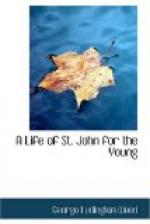Through the door of the Upper Room left ajar by three Evangelists, we catch glimpses of the group around the table of the Last Supper. Through it as opened wide by John we hear the voice of Jesus as He utters His farewell words. He comforts His disciples and tells of heavenly mansions. He gives His peace in their tribulations. He promises the Holy Spirit as a Comforter. He closes His address, even in this hour of sadness and apparent defeat, with these wonderful words, “Be of good cheer; I have overcome the world.”
And now as John still holds open the door, we hear the voice of prayer, such as nowhere else has been offered. It is ended. There are moments of silence, followed by a song of praise. Then John closes the door of the Upper Room, which we believe was opened again as the earliest home of the Christian Church. There we shall see him again with those who, because of his experience with his Lord in that consecrated place, gave him the name of “The Bosom Disciple.”
[Illustration: IN GETHSEMANE Gustave Dore Page 163]
CHAPTER XXIV
With Jesus in Gethsemane
“He went forth
with His disciples over the brook Kidron, where was
a garden.”—John
xviii. 1.
“Then cometh Jesus
with them unto a place called Gethsemane, and
saith unto His disciples,
Sit ye here while I go yonder and
pray.”—Matt.
xxvi. 36.
“And He taketh
with Him Peter and James and John, ... and He saith
unto them, ... abide
ye here, and watch.”—Mark xiv.
33, 34.
“And He went forward
a little, and fell on the ground, and prayed.”
v. 35.
John was our leader to the Upper Room. And now he guides us from it, saying, “Jesus ... went forth with His disciples.” That phrase “went forth” may suggest to us much more than mere departure. The banquet of love was over. The Lord’s cup of blessing and remembrance had been drunk by His “little children,” as He affectionately called them. He was now to drink the cup the Father was giving His Son—a mysterious cup of sorrow. It was probably at the midnight hour that Jesus “went forth” the last time from Jerusalem, which He had crowned with His goodness, but which had crowned Him with many crowns of sorrow.
Other Evangelists tell us that He went “to the Mount of Olives,” “to a place called Gethsemane.” John shows us the way thither, and what kind of a place it was. Jesus went “over the ravine of the Kidron,” in the valley of Jehoshaphat. At this season of the year it was not, as at other times, a dry water-bed, but a swollen, rushing torrent, fitting emblem of the waters of sorrow through which He was passing. Whether the name Kidron refers to the dark color of its waters, or the gloom of the ravine through which they flow, or the sombre green of its overshadowing cedars, it will ever be a reminder of the darker gloom that overshadowed John and His Master, as they crossed that stream together to meet the powers of darkness in the hour which Jesus called their own.




